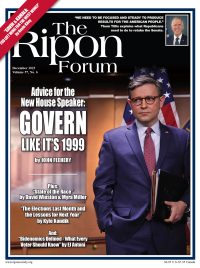
The month of November featured contradictory electoral signs.
On the one hand, President Joe Biden’s position curdled in public opinion polling – his approval rating was a little below 40 percent in national polling, per the FiveThirtyEight polling average, and he trailed former President Donald Trump in several prominent national polls.
Included in the cross-tabs of some of these surveys were worrying signs for the president, such as weakness among young and nonwhite voters, two key pillars of the Democratic coalition – although it is worth noting that general election polling this far out from a presidential election is an unreliable indicator of the actual results the following November.
On the other hand, the election results in November did not point to big problems for Democrats. While Republicans flipped the open Louisiana governorship in an October election, Democrats performed well in a pair of other red state governorships, re-electing Governor Andy Beshear in Kentucky and coming within a few points of unseating Governor Tate Reeves in Mississippi. Democrats also narrowly won both chambers of the closely-watched state legislature in Virginia and held an important open state Supreme Court seat in Pennsylvania, one of the handful of most important states in the Electoral College.
The election results in November did not point to big problems for Democrats.
Biden’s approval rating has been weak for more than two years now, dating back to late summer 2021, when his approval rating dipped below his disapproval rating in national tracking – a dip that coincided with the collapse of the Afghan government in the aftermath of the U.S. withdrawal. A few months later, in November 2021, Republicans had a strong election, but the results were much more mixed in 2022 and 2023, showing that Democrats could survive despite Biden’s troubles.
A key difference between 2021 and 2022 and 2023 is that those two latter elections came after the Supreme Court’s momentous Dobbs decision, which removed the robust federal protections for abortion rights that the previous Roe decision had guaranteed a half century earlier. Abortion rights has not been a silver bullet for Democrats in every election, but their position is pretty obviously closer to where the median voter is on the issue than the Republican position, and Democrats have been able to use the abortion issue effectively in a variety of different places, even in a conservative state like Kentucky.
Of course, presidential elections are different than mid-terms or odd-numbered year elections, with much larger electorates and the party leaders themselves on the ballot.
With the primary season looming, there is an odd dynamic – scores of Americans dread the prospect of a 2020 rematch, and both Biden and Trump have favorability ratings hovering only around 40 percent, with unfavorability around 55 percent, meaning that a sizable share of voters have a negative view of both candidates. Yet despite these problems for both Biden and Trump, neither appear to be in much danger of losing their respective nominating contests. In fact, there is an outside possibility that neither will lose even a single nominating contest, a combined sweep by the two major party candidates that would be unprecedented in the modern era of presidential nominations (which dates back to the democratization of the primary process in both parties in the 1970s).
Of course, presidential elections are different than mid-terms or odd-numbered year elections, with much larger electorates and the party leaders themselves on the ballot.
Of the two, Trump still faces the more serious challenge as a non-incumbent facing prominent challengers within his own party, but he remains well ahead in essentially every national and state-level poll, with his leading rivals – Governor Ron DeSantis of Florida and former Governor and UN Ambassador Nikki Haley of South Carolina – unable to consolidate the non-Trump vote.
To borrow a Yogi Berra-ism, it gets late early in both party nominating processes. After a handful of early state contests in January and February, delegate-rich Super Tuesday looms in early March, including both the mega-states of California and Texas. Nearly half of all the available delegates on both sides will be awarded by the end of those contests, with a collection of other major states (Florida, Illinois, and Ohio, among others) voting just two weeks later.
Biden does not appear to face an opponent capable of defeating him in his primary. Trump may or may not end up facing such an opponent, but if he is to face a stern challenge, whoever his top rival ends up being will have to demonstrate strength early on. Looming in the background, but likely moving to the foreground, are Trump’s myriad legal woes, although at this point that seems like more of a general election issue than a primary election one.
Assuming Biden and Trump are the nominees, the campaign could be more like 2016 than 2020. In addition to a shared unpopularity that would be reminiscent of 2016’s contest between Trump and Hillary Clinton, voters may be more open to third party options, just as they were in 2016, when the total third party vote reached 6 percent of all votes cast (that fell to about 2 percent in 2020).
Third party candidates typically poll better than they perform, meaning that surveys likely will overstate their eventual share of the vote, further impacting our ability to get a sense of the true nature of the race between the major party nominees.
We noted above the contradictory electoral signs of late 2023. Next fall, the electoral picture may remain hazy.
Kyle Kondik is managing editor of Sabato’s Crystal Ball, the University of Virginia Center for Politics’ authoritative, nonpartisan newsletter on campaigns and elections. Sign up for the Crystal Ball’s free mailing list at centerforpolitics.org/crystalball




